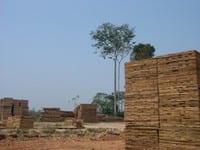 Valle, D., Schulze, M., Vidal, E., Grogan, J. & Sales, M., 2006.
Valle, D., Schulze, M., Vidal, E., Grogan, J. & Sales, M., 2006.
Commercial volume increment based on permanent plot data has frequently been used to determine cutting cycles and logging intensities that do not deplete forest timber resources, and that are therefore compatible with sustainable forest management.We evaluate three potential sources of increment bias from long-term permanent plot data monitoring forest recovery after reduced-impact logging (RIL) and conventional or predatory logging (CL) in eastern Amazonia: (1) forest monitoring length; (2) minimum diameter at breast height (DBH) included in measurements; (3) defective stems. Short monitoring intervals, inclusion of trees from sub-merchantable size classes, and failure to account for defective stems all lead to overestimates of annual commercial volume increment between first and second harvests. We found that these sources of bias greatly inflated the estimate of volume increment during the projected 30-year cutting cycle.Without controlling for biases, estimated volume increments were 1.14 and 0.18 m 3 ha -1 year -1 for RIL and CL, respectively; increment corrected for bias decreased to 0.19 and 0 m 3 ha -1 year -1 over the 30- year period. We propose alternative methods for calculating and reporting commercial volume increment.
This article is available to subscribers at Forest Ecology and Management website ( http://www.elsevier.com/locate/foreco ).
